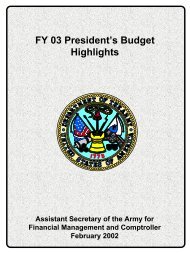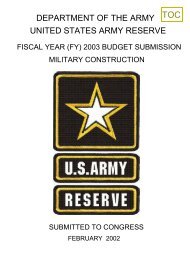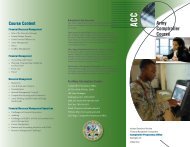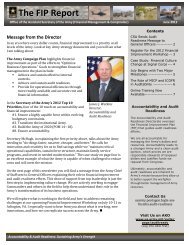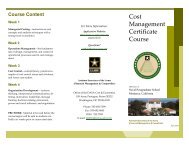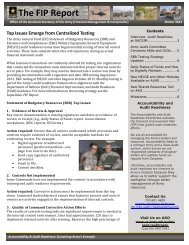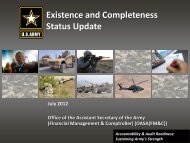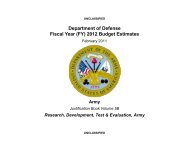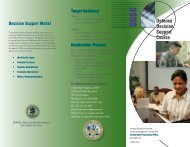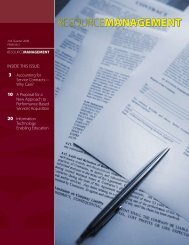Army Audit Readiness Strategy FY 2013 - Army Financial ...
Army Audit Readiness Strategy FY 2013 - Army Financial ...
Army Audit Readiness Strategy FY 2013 - Army Financial ...
You also want an ePaper? Increase the reach of your titles
YUMPU automatically turns print PDFs into web optimized ePapers that Google loves.
<strong>FY</strong> <strong>2013</strong> <strong>Army</strong> <strong>Audit</strong> <strong>Readiness</strong> <strong>Strategy</strong><br />
Working Capital Fund and LMP discovery and gap analysis, testing, and corrective action audit<br />
readiness activities, similar to the <strong>Army</strong> General Fund and GFEBS activities, by mid-<strong>FY</strong> 2012.<br />
4.3.3 Global Supply System–<strong>Army</strong> (GCSS-A)<br />
GCSS–A integrates the <strong>Army</strong> supply chain, obtains accurate equipment readiness, supports split<br />
base operations, and receives up-to-date status on maintenance actions and supplies in support of<br />
the warfighter. On August 9, 2011, the GCSS-A program received its Milestone C approval from<br />
the Defense Acquisition Board. The granting of Milestone C moves the GCSS-A program from<br />
the Engineering Manufacturing and Deployment Phase into the Production and Deployment<br />
Phase. After a successful Initial Operational Test & Evaluation (IOT&E), the program will ask<br />
for a Full Deployment Decision, which allows the program to deploy to the entire <strong>Army</strong>. The<br />
Full Deployment Decision is expected in mid-December 2012.<br />
The GCSS-A controls assessment began in September 2011 with a focus on the status of key<br />
policies and procedures. Initial testing of controls began in <strong>FY</strong> 2012 and was completed by June<br />
30, 2012. The <strong>Army</strong> will remediate control gaps by December 31, 2012 in advance of the SBR<br />
Exam 3, which will include an audit readiness assessment of GCSS-A.<br />
4.3.4 Integrated Personnel and Pay System–<strong>Army</strong> (IPPS-A)<br />
IPPS–A will be the <strong>Army</strong>’s integrated pay system, replacing the legacy systems, and serving as a<br />
critical piece of the <strong>Army</strong>’s future systems environment. The <strong>Army</strong> is revising the system<br />
development strategy and is working toward establishing a Milestone B decision date.<br />
4.4 Command <strong>Audit</strong> <strong>Readiness</strong><br />
OASA(FM&C) will complement activities across Commands in support of the <strong>Army</strong>’s audit<br />
readiness milestones. OASA(FM&C) will support ongoing audit preparation activities with a<br />
command level emphasis, including testing controls and balances for budgetary resources,<br />
property accountability, and information systems. In addition, OASA(FM&C) will facilitate<br />
command level audit readiness training across locations and monitor the implementation and<br />
completion of recommended corrective actions following testing. OASA(FM&C) will support<br />
the development of command audit readiness strategies to enhance the overall audit readiness<br />
strategy of the <strong>Army</strong> in accordance with existing audit readiness activities.<br />
4.5 Full <strong>Financial</strong> Statement Assertion<br />
As the <strong>Army</strong> progresses toward meeting the SBR and E&C objectives, it must also keep in mind<br />
the Congressionally-mandated requirement of obtaining audit readiness of all financial<br />
statements, including the Balance Sheet, Statement of Net Cost, and Statement of Changes in Net<br />
Position, by <strong>FY</strong> 2017. Working toward meeting this major milestone cannot wait until after the<br />
<strong>Army</strong> has met its SBR and E&C objectives in <strong>FY</strong> 2014 and <strong>FY</strong> 2015, respectively. Some of the<br />
current SBR, E&C, and FBWT efforts enable the <strong>Army</strong> to meet the broader financial statement<br />
goals, including:<br />
Leveraging E&C supporting documentation to establish valuation for legacy assets.<br />
Taking advantage of the benefits of systems implementation to address long-standing<br />
balance sheet deficiencies, such as Accounts Receivable, Accounts Payable, and<br />
unsupported accounting adjustments.<br />
Accountability & <strong>Audit</strong> <strong>Readiness</strong>: Sustaining <strong>Army</strong>’s Strength 21



